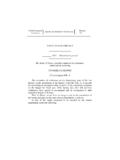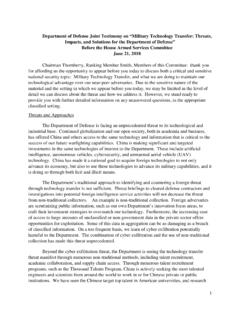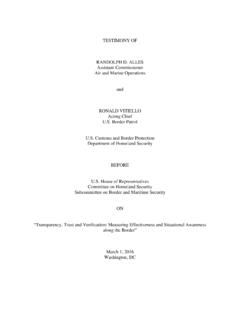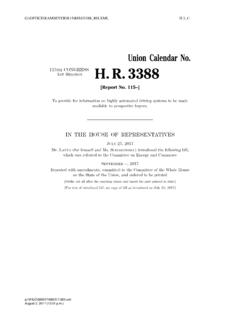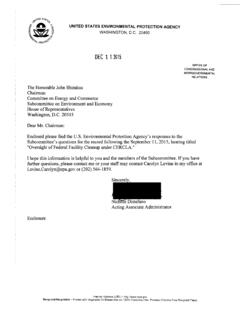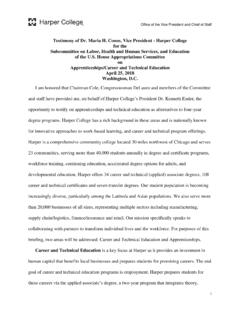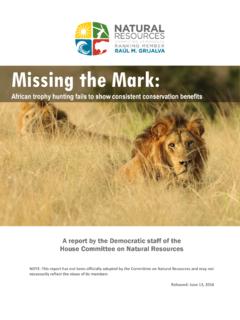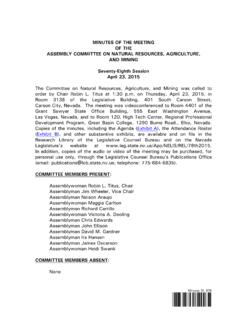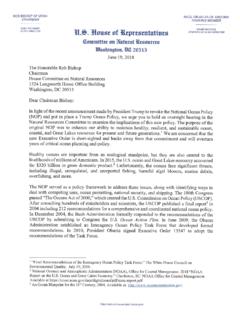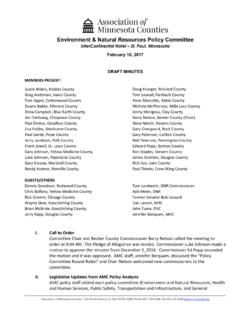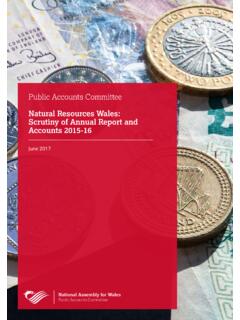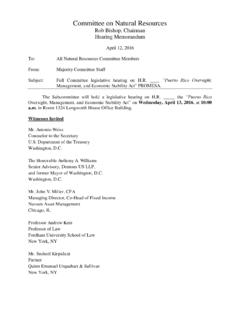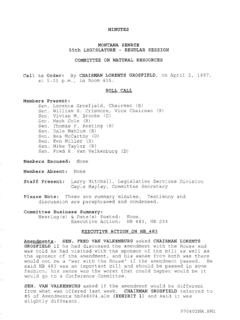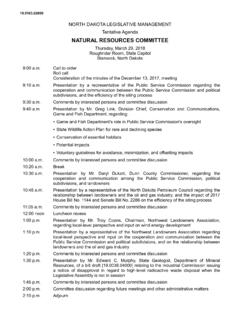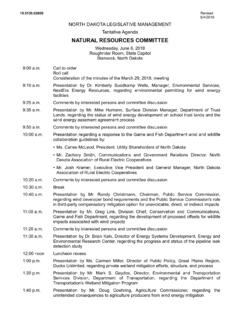Transcription of Committee on Natural Resources - Document Repository
1 Committee on Natural Resources Rob Bishop, Chairman Markup Memorandum Page 1 of 4 June 20, 2017 To: All Natural Resources Committee Members From: Majority Committee Staff Subcommittee on Indian, Insular, and Alaska Native Affairs (x6-9725) Markup: S. 249 (Sen. Tom Udall), To provide that the Pueblo of Santa Clara may lease for 99 years certain restricted land, and for other purposes. June 22 & 27, 2017; 1324 Longworth HOB _____ S. 249 (Sen. Udall), To provide that the pueblo of Santa Clara may lease for 99 years certain restricted land, and for other purposes Summary of the Bill S. 249 would amend the Indian Long-Term Leasing Act of 19551 to authorize the Pueblo of Santa Clara and the Ohkay Owingeh Pueblo to lease their tribal lands for a term of up to 99 years, subject to approval by the Secretary of the Interior.
2 Such leases may be for a variety of non-mineral development purposes as mineral leasing of tribal lands is regulated under other law. While current law authorizes the two tribes to lease lands held in trust for their benefit, the purpose of S. 249 is to authorize the tribes to lease their trust land and restricted fee land for up to 99 years, subject to the approval of the Secretary of the Interior. Cosponsors Sen. Martin Heinrich (D-NM) Background In 1834 with the enactment of the Non-intercourse Act,2 land transactions with Indians were prohibited unless authorized by Congress. Over time, such restrictions came to apply primarily to lands held in trust by the United States for the benefit of individual Indians or tribes ( trust lands ), and to lands title to which is held in fee by Indians or tribes subject to a restriction on alienation ( restricted fee lands ).
3 In 1955, Congress passed what is commonly known as the Indian Long-Term Leasing Act (the Act) to overcome the Non-Intercourse Act. The Act generally authorizes any Indian lands (in trust or in restricted fee status) to be leased by their Indian owners, subject to the approval of the Secretary of the Interior, for public, religious, educational, recreational, 1 25 415(a). 2 25 177. Page 2 of 4 residential, or business for a term of not to exceed twenty-five years except for grazing purposes, in which case the term shall not exceed ten years. The original 1955 specified that non-grazing leases may be renewed up to one additional term of 25 years, under rules and regulations developed by the Congress has amended the Long Term Leasing Act more than 40 times to adjust the terms and conditions of leases of Indian lands, and to authorize leases of specific Indian lands by their Indian owners for a term of up to 99 years, subject to approval of the Secretary.
4 Relevant to S. 249, in 1992 the Act was amended to authorize leasing of up to 99 years for lands held in trust for the Pueblo of Santa Clara,4 and in 2011 the Act was amended to authorize 99 year leases for lands held in trust for the Ohkay Owingeh Pueblo (formerly known as the Pueblo of San Juan).5 The Santa Clara Pueblo is located in Rio Arriba County, New Mexico, and is home to 1,018 tribal Along with the Ohkay Owingeh, it is a member of the Eight Northern Pueblos of New Located on the Rio Grande, about a mile south of Espa ola, New Mexico, the Santa Clara Pueblo is a total of square miles, or roughly 24 acres. Currently, the reservation land consists of land granted from the Spanish via land grant, and reservation land established in 1905 via Executive The Ohkay Owingeh Pueblo, previously known as the San Juan Pueblo as recently as 2005, is a reservation along the Rio Grande approximately 25 miles north of Santa Fe and is home to 2,723 enrolled members.
5 Originally, the Supreme Court ruled that Indians were not the original settlers of this territory and reduced their land grant to 5,000 Since that time, however, additional lands have been attained by the reservation. As the Capital of the Eight Northern Pueblos in New Mexico, it is an important cultural touchstone for Indian Tribes in New Mexico and the tribal governance structure. While the Santa Clara and Ohkay Owingeh Pueblos currently have 99-year leasing authority, such authority applies only to the tribes trust lands. The purpose of S. 249 is to clarify that the tribes may lease their restricted fee lands for up to 99 years, subject to the usual approval of the Secretary. Cost The CBO has estimated that enactment would have no significant effect the federal Administration s Position 3 Pub.
6 L. 255 - Aug. 9, 1955, ch. 615, Sec. 1, 69 Stat. 539. 4 102-497, 106 Stat. 3256. 5 111-381, 124 Stat. 4133. 6 2010 US Census Data. 7 Eight Northern Pueblos, Inc. 8 Executive Order XXVI (1905). 9 v. Sandoval, 167 278. 10 Page 3 of 4 At the Subcommittee on Indian, Insular and Alaska Native Affairs legislative hearing on June 7, 2017, the Trump Administration testified in support of the bill. Effect on Current Law (Ramseyer) Showing current law as amended by S. 249, as passed the Senate [New text is highlighted in yellow; text to be deleted is bracketed and highlighted in blue] Subsection (a) of the first section of the Act of August 9, 1955 (commonly known as the Long-Term Leasing Act ) (25 415(a)) (a) Authorized purposes; term; approval by Secretary.
7 Any restricted Indian lands, whether tribally or individually owned, may be leased by the Indian owners, with the approval of the Secretary of the Interior, for public, religious, educational, recreational, residential, or business purposes, including the development or utilization of Natural Resources in connection with operations under such leases, for grazing purposes, and for those farming purposes which require the making of a substantial investment in the improvement of the land for the production of specialized crops as determined by said Secretary. All leases so granted shall be for a term of not to exceed twenty-five years, except leases of land located outside the boundaries of Indian reservations in the State of New Mexico, leases of land on the Aqua Caliente (Palm Springs) Reservation, the Dania Reservation, the Pueblo of Santa Ana (with the exception of the lands known as the Santa Ana Pueblo Spanish Grant )
8 , the reservation of the Confederated Tribes of the Warm Springs Reservation of Oregon, land held in trust for the Coquille Indian Tribe, land held in trust for the Confederated Tribes of Siletz Indians, land held in trust for the Confederated Tribes of the Coos, Lower Umpqua, and Siuslaw Indians, land held in trust for the Klamath Tribes, and land held in trust for the Burns Paiute Tribe, the Moapa Indian Reservation, the Swinomish Indian Reservation, the Southern Ute Reservation, the Fort Mojave Reservation, the Confederated Tribes of the Umatilla Indian Reservation, the Burns Paiute Reservation, the Coeur d Alene Indian Reservation, the Kalispel Indian Reservation and land held in trust for the Kalispel Tribe of Indians, the Puyallup Tribe of [Indians, ,]
9 Indians, the pueblo of Cochiti, Ohkay Owingeh pueblo, the pueblo of Pojoaque, the pueblo of Santa Clara, the pueblo of Tesuque, the pueblo of Zuni, the Hualapai Reservation, the Spokane Reservation, the San Carlos Apache Reservation, the Yavapai-Prescott Community Reservation, the Pyramid Lake Reservation, the Gila River Reservation, the Soboba Indian Reservation, the Viejas Indian Reservation, the Tulalip Indian Reservation, the Navajo Reservation, the Cabazon Indian Reservation, the Muckleshoot Indian Reservation and land held in trust for the Muckleshoot Indian Tribe, the Mille Lacs Indian Reservation with respect to a lease between an entity established by the Mille Lacs Band of Chippewa Indians and the Minnesota Historical Society, leases of the [the]
10 Lands comprising the Moses Allotment Numbered 8 and the Moses Allotment Numbered 10, Chelan County, Washington, and lands held in trust for the Las Vegas Paiute Tribe of Indians, and lands held in trust for the Twenty-nine Palms Band of Luiseno Mission Indians, and lands held in trust for the Reno Sparks Indian Colony, lands held in trust for the Torres Martinez Desert Cahuilla Indians, lands held in trust for the Guidiville Band of Pomo Indians of the Guidiville Indian Rancheria, lands held in trust for the Confederated Tribes of the Umatilla Indian Reservation, lands held in trust for the Confederated Tribes of the Warm Springs Reservation of Oregon, and Page 4 of 4 lands held in trust for the Cow Creek Band of Umpqua Tribe of Indians, land held in trust for the Prairie Band Potawatomi Nation, lands held in trust for the Cherokee Nation of Oklahoma, land held in trust for the Fallon Paiute Shoshone Tribes, [lands held in trust for the Pueblo of Santa Clara,]

